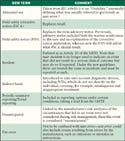Postmarket Vigilance in Europe: New Guidance for Manufacturers
New European medical device postmarket vigilance guidelines have been published. By the end of 2007, manufacturers selling in Europe should update their quality systems to comply.
September 1, 2007
REGULATORY OUTLOOK
|
The European Commission has recently published an updated guidance on the postmarketing vigilance requirements for medical devices. All medical device manufacturers placing medical devices on the European market should obtain a copy of the new guidelines and ensure that their procedures for reporting incidents are brought into line. The new guidelines reference the following three directives:
Active Implantable Medical Devices (AIMD) Directive, 90/385/EEC.
Medical Devices Directive (MDD), 93/42/EEC.
In Vitro Diagnostic Medical Devices Directive (IVDD), 98/79/EC.
The guidance has been updated from the April 2001 version to add further detail in the light of experience from the national competent authorities (NCAs) of member states. It includes specific information relating to in vitro diagnostic devices and takes into account regulatory guidance documents on vigilance and postmarket surveillance published by the Global Harmonization Task Force (GHTF).
The guidelines have been issued as a revised medical devices (MEDDEV) document, reference 2.12-1, rev. 5, dated April 2007.1 They were published on the European Commission Web site in June 2007. The guidelines have been virtually rewritten from the 2001 version, with changes to some of the basic terminology and the inclusion of new definitions. Some of the ideas within the document are taken from the publications of Study Group 2 of the GHTF.
From a manufacturer's point of view, the new guidelines are stricter on the timing for reporting incidents. They also contain new reporting concepts, including periodic summary reporting and trend reporting.
Terms that have disappeared from the guidelines include advisory notice, near incident, and recall (aside from a passing reference).
Although the MEDDEV documents are not legally binding, and adoption as national guidelines by member states is not guaranteed, it is likely that all NCAs will expect manufacturers and their authorized representatives to comply. The guidelines are effective January 1, 2008, with a transitional period ending December 31, 2007, allowing for gradual implementation by affected organizations.
Applicability
The applicability of the reporting rules in the new document has been expanded to include: “Devices that do not carry the CE mark because they were placed on the market before the entry into force of the medical devices directives,” whereas the previous version was applicable only to “devices that do not carry the CE mark, where such incidents lead to corrective action relevant to CE-marked devices.” This brings devices that were designed, manufactured, and marketed before publication or implementation of the directives within the guidelines. This change may be controversial because, by association, it extends the scope of the vigilance requirements to devices placed on the market prior to the directives becoming law.
|
Table I. (click to enlarge) Explanations of the new vigilance terminology from the European Commission's updated guidelines. |
The guidelines have also been extended to include “devices that do not carry the CE mark but fall under the directives' scope,” which would include custom-made devices and devices being used for clinical investigations. These products were specifically excluded from the scope of the 2001 guidance, although a footnote explained that “incidents occurring during clinical investigations meeting the same criteria as those reportable under the Vigilance System should be notified to the relevant Competent Authority.”
The MEDDEV document includes a number of new terms, which are reviewed and discussed in Table I.
What and When to Report
|
Table II. (click to enlarge) Reporting criteria for an event to be treated as an incident. |
The identification of an event that must be considered an “incident,” and therefore must be reported, has been clarified. Table II lists the basic criteria that must be met for an event to be treated as an incident.
The definition of serious deterioration in the state of health has been expanded to include any “indirect harm” as a consequence of incorrect diagnostic or IVD test results.
Under the revised guidelines, NCAs could accept periodic summary reporting of incidents from manufacturers once one or more initial reports have been submitted and evaluated by the NCA. Periodic summary reporting may also be appropriate for reporting incidents that occur after the issuance of a field safety notice (FSN), or for well-documented incidents already identified in the manufacturer's risk analysis, once initial reports have been evaluated by the NCA. For the already-identified incidents, trigger levels for interim reporting should be agreed upon with the NCA.
|
Table III. (click to enlarge) Reporting timescales. |
The previous timescales of 10 days for reporting incidents and 30 days for reporting near incidents (which were modified by some member states in national legislation) have been replaced. The new wording indicates that reports should be filed as soon as the manufacturer becomes aware of an incident, but with maximum time periods, as shown in Table III.
The conditions under which reporting is not required have been expanded and clarified with no significant changes, although one reason has been removed (see Table II). The one condition that has been removed concerns incidents that occur after an FSN has been issued. These may now require periodic summary reporting. Manufacturers should, however, monitor such events. Upon identifying any significant increases by means of trend reports, manufacturers should inform the NCA of the increase, regardless of whether periodic summary reporting has been agreed upon with the NCA.
Abnormal use need not be reported, but use errors that actually result in death or a serious deterioration in the state of health are reportable. Use errors that may result in death or a serious deterioration in the state of health become reportable if a significant increasing trend is noted, or if the manufacturer initiates corrective action to avoid such incidents.
Access to Suspect Devices
The section relating to access to suspect devices has been expanded to suggest that if a manufacturer's initial assessment of the device may require altering it in any way, then in requesting the NCA's permission to proceed, the manufacturer should include a timescale for reply, along the following lines: “We assume destructive analysis can begin 10 days from the date of this report, unless the NCA contacts the manufacturer within this timeframe, opposing destructive analysis.”
Format of Field Safety Corrective Actions and Field Safety Notices
The section previously titled “Systematic Recalls” is now called “Field Safety Corrective Action (FSCA).” This section includes advice to manufacturers to use the methodology described in EN ISO 14971:2000 in their assessment of the need for FSCA. However, manufacturers should clearly use the most recent version of the standard (currently, the 2007 edition).3
The recommended format of the initial report to the NCAs is more detailed than the previous version. In addition to answering the questions on the form, the manufacturer is advised to include copies of other documents, including relevant extracts from the risk management file, whether the resulting action is corrective or preventive, advice to users and distributors, and a copy of the FSN.
The MEDDEV document suggests that a draft of the FSN should be submitted to the relevant NCA prior to release, allowing 48 hours for comments to be received. The previous MEDDEV contained little guidance on what should be included in an FSN, but the new document puts forward comprehensive advice for manufacturers, including a recommendation to use company letterhead paper and a clear title, with the words “Urgent Field Safety Notice.” A factual statement that explains the reasons for the FSCA, along with what actions should be taken by the users of the device should also be included.
In addition, the guidelines stress that any comments or attempts to play down the level of risk in an inappropriate manner must be excluded, as must any advertisements for products or services.
Finally, the guidance suggests the use of an acknowledgement form for the users to return to the sender, thereby allowing the manufacturer to demonstrate that the user group has received and acted upon the FSCA.
NCAs, the European Commission, Notified Bodies, and Users
The role of NCAs has not been altered significantly, and it still includes the possibility of monitoring of the manufacturer's investigation and subsequent actions, together with notified bodies, other NCAs, and additional organizations, such as test houses.
The 2001 MEDDEV was silent on the roles within the vigilance system of the European Commission and notified bodies, but the new guidelines include brief overviews of their responsibilities and supporting activities.
Healthcare organizations, such as hospitals and other clinical facilities, were mentioned in the earlier edition as playing a vital role in providing the first link in the vigilance chain, even though there are no legal responsibilities on them under the directives concerned. The revised document explains this lack of a legal requirement, but stresses that only with the close involvement of users can the implementation of effective postmarketing corrective and preventive actions be achieved.
An annex to the new version of the guidance provides advice to manufacturers that would result in a greater involvement of users in vigilance activities to ensure the most efficient and effective outcomes. Other annexes include templates for an initial report form, an FSCA report form, an FSN, and a form for exchange of information between NCAs.
Conclusion
The new guidelines contain some controversial aspects, including the extension of their scope and the new approach of immediate reporting unless delays can be justified. However, they also provide additional clarity and more-detailed advice in many areas. Periodic or trend reporting under certain conditions is now allowed, as a result of the integration of certain GHTF concepts.
Although a transition period is allowed until the end of 2007, the revised guidelines will undoubtedly result in the need for manufacturers, authorized representatives, and distributors to quickly make substantial changes to their standard operating procedures (SOPs) and other documents. Materials requiring revision may potentially include the following:
Quality manual.
Complaint-handling SOP.
Incident-reporting SOP.
Recall, field corrective action, and advisory notice SOPs.
Clinical investigation SOP.
Authorized representative agreements.
Distributor agreements.
Manufacturers marketing medical devices in Europe, as well as their distributors and authorized representatives, urgently need to review the revised guidance document in detail. It is essential that manufacturers make the necessary changes to their quality management system and are ready to implement the new postmarket vigilance reporting guidelines beginning in January 2008.
Roger Gray is director of European regulatory affairs at Donawa Consulting (Rome). He can be contacted at [email protected].
References
1. MEDDEV 2.12-1, rev. 5, “Guidelines on a Medical Devices Vigilance System” (Brussels: European Commission, 2007 [cited 19 July 2007]); available from Internet: http://ec.europa.eu/enterprise/medical_devices/meddev/2_12_1-rev_5-2007.pdf.
2. IEC 60601-1-6, 1st ed., “Medical Electrical Equipment—Part 1-6: General Requirements for Basic Safety and Essential Performance—Collateral Standard: Usability” (Geneva: International Electrotechnical Commission, 2004).
3. ISO 14971, 2nd ed., “Medical Devices—Application of Risk Management to Medical Devices” (Geneva: International Organization for Standardization, 2007).
Copyright ©2007 Medical Device & Diagnostic Industry
About the Author(s)
You May Also Like




.png?width=300&auto=webp&quality=80&disable=upscale)

